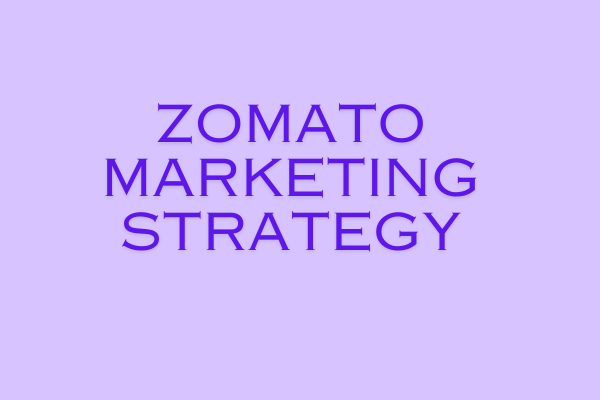
Zomato marketing strategy a leading online food delivery and restaurant discovery platform, has garnered significant attention not only for its diverse offerings but also for its robust marketing strategy. In an era where digital presence and brand visibility are paramount, Zomato has crafted a comprehensive marketing approach that resonates with its target audience and drives business growth.
Introduction to Zomato
What is Zomato?
Zomato started as a restaurant discovery platform in 2008 and has since evolved into a one-stop destination for food enthusiasts, offering services such as food delivery, table reservations, and reviews.
Zomato's Services
Zomato’s services extend far beyond mere food delivery. At its core, the platform serves as a comprehensive ecosystem for culinary enthusiasts, seamlessly integrating restaurant discovery, food ordering, and user reviews. Leveraging sophisticated algorithms and user data, Zomato provides personalized recommendations tailored to individual preferences, enhancing the overall dining experience for its users.
Furthermore, Zomato marketing strategy is deeply rooted in community engagement and brand advocacy. Through initiatives like Zomato Gold and Zomato Pro, the platform incentivizes user loyalty while forging partnerships with restaurants to drive customer acquisition and retention. Additionally, Zomato’s strategic collaborations with influencers and celebrities amplify its brand presence, fostering a sense of authenticity and trust among consumers.
In essence, Zomato marketing strategy transcends traditional boundaries, leveraging technology, data analytics, and strategic partnerships to create a dynamic ecosystem that caters to the evolving needs of modern consumers. By analyzing its comprehensive suite of services, we gain valuable insights into the intricacies of Zomato’s marketing approach and its enduring impact on the food delivery industry.
Importance of Marketing Strategy
Effective marketing strategy plays a pivotal role in the success of any business. It not only enhances brand visibility but also helps in building a loyal customer base and staying ahead of competitors.
Understanding Zomato Marketing Strategy
In today’s fiercely competitive digital landscape, the importance of a well-crafted marketing strategy cannot be overstated. Zomato, the food-tech giant, exemplifies this truth through its meticulously designed marketing approach. At the core of Zomato’s success lies a strategy that not only promotes its brand but also fosters customer engagement and loyalty.
Firstly, a robust marketing strategy enables Zomato to effectively communicate its value proposition to its target audience. By leveraging various channels such as social media, email marketing, and influencer partnerships, Zomato ensures that its message reaches potential customers in the most impactful manner possible.
Moreover, a carefully devised marketing strategy allows Zomato to stay ahead of the curve in a rapidly evolving market. Through market research and analysis, Zomato identifies emerging trends and consumer preferences, allowing the company to tailor its offerings accordingly and maintain its competitive edge.
Target Audience Analysis
Understanding Zomato marketing strategy hinges on dissecting their target audience. From food enthusiasts seeking culinary adventures to busy professionals craving convenience, Zomato caters to a diverse demographic. By delving into user demographics, preferences, and behaviors, Zomato crafts personalized experiences and tailored promotions. Analyzing geographic locations, socio-economic backgrounds, and dining habits provides invaluable insights, guiding Zomato’s marketing efforts. With data-driven precision, Zomato ensures its messaging resonates with each segment, fostering brand loyalty and driving engagement. Delve deeper into Zomato’s strategy, uncovering the intricacies of their target audience analysis and the key to their marketing prowess.
Brand Positioning
Zomato positions itself as more than just a food delivery platform, emphasizing its role in fostering culinary exploration, supporting local businesses, and enhancing the overall dining experience
Competitive Analysis
Zomato continuously monitors the competitive landscape, analyzing market trends, consumer preferences, and competitor strategies to stay ahead in the highly competitive food delivery industry.
Zomato Marketing Strategies
Customer-Centric Approach:
Zomato focuses on understanding the needs and preferences of its customers. It uses data analytics to gather insights into customer behavior, such as popular cuisines, dining trends, and preferred restaurants.
User Experience:
Zomato emphasizes providing a seamless user experience across its platforms, including its website and mobile app. This includes easy navigation, intuitive design, and convenient features such as user reviews, ratings, and restaurant recommendations.
Content Marketing:
Zomato invests in content marketing to engage with its audience and provide value beyond just food delivery. This includes articles, blogs, and videos on topics such as food trends, restaurant reviews, and cooking tips.
Social Media Marketing:
Zomato leverages social media platforms to connect with its audience, share user-generated content, and promote its services. It actively engages with users on platforms like Facebook, Instagram, and Twitter to build a community around food and dining experiences.
Partnerships and Collaborations:
Zomato collaborates with restaurants, food bloggers, influencers, and other relevant partners to expand its reach and enhance its offerings. These partnerships may include promotional campaigns, exclusive deals, or joint events.
Personalization:
Zomato utilizes personalization techniques to tailor its marketing efforts to individual users’ preferences and behaviors. This may include personalized recommendations, targeted promotions, and customized communications.
Referral Programs and Incentives:
Zomato incentivizes users to refer friends and family to its platform through referral programs, discounts, and rewards. This helps drive user acquisition and retention while leveraging the power of word-of-mouth marketing.
Localized Marketing:
Zomato adopts a localized approach to marketing by catering to the unique preferences and tastes of different regions. It may promote local cuisines, highlight popular restaurants in specific areas, and engage with local communities through targeted campaigns.
Conclusion
In conclusion, Zomato marketing strategy is a testament to its commitment to delivering value, fostering customer engagement, and driving business success in the digital age. By understanding its audience, embracing innovation, and leveraging technology effectively, Zomato has established itself as a leading player in the global food delivery market.
FAQs (Frequently Asked Questions)
Yes, Zomato often runs promotional campaigns offering discounts or free delivery for first-time users. These offers may vary depending on the user’s location and the current marketing initiatives.
Zomato allows users to write reviews and give ratings based on their dining experiences. These reviews and ratings are visible to other users and help them make informed decisions when choosing a restaurant
Yes, restaurants have the option to respond to customer reviews on Zomato. This allows them to address feedback, thank satisfied customers, and resolve any issues or concerns raised by dissatisfied customers.
Yes, Zomato offers loyalty programs such as Zomato Gold, which provides members with exclusive dining perks, discounts, and priority reservations at participating restaurants.
Zomato utilizes data and analytics tools to track user behavior, measure campaign performance, and identify trends and patterns. This data-driven approach allows Zomato to optimize its marketing strategy and enhance the user experience.





